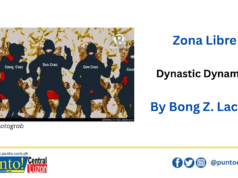THERE IS much ado about the Capampangan.
More than a tribe, the old Capampangan prides himself as a separate race. Perhaps in bitter rebellion against the diminution of his once vast kingdom that was said to have stretched from the mouth of the Pasig River in Tondo to the upper reaches of the Chico River in Cagayan Valley.
Mayhaps, in a vicious reaction to the consequent waning of the primacy of his lingua franca which is now limited to just the province and the southern half of Tarlac, plus a single town in each of Pampanga’s contiguous provinces of Bataan, Bulacan, and Nueva Ecija.
He may not be the distinct species that he likes to make of himself, but the Capampangan unarguably stands out when ranged against his Filipino fellows. You will know the Capampangan, easily.
Food is his passion. A gourmet and a gourmand is the Capampangan as he turns snails and frogs, dogs and field mice, pythons and cobras, locusts and mole crickets into exotic dishes rivaling ambrosia itself. And no meal for him without the attendant condiments of patis, toyo, and aslam.
And who could love the pungent buro more, other than the Capampangan?
How the Capampangan loves to party! Just about every occasion is a cause for celebration. A Capampangan fiesta is unrivalled in the excesses of bacchanalia. The fattened calf or pig, even good old Bantay, get served on the Capampangan table. Beer goes by the truckful. No money is no excuse to feast. E ca macapagtawó? Ala cang marine tau. Nananu ya itang mag-five-six qng cantu? Feast for the day, all the year to the usurer.
Fashion is an everyday statement. In colleges and universities, the ubiquitous Capampangan student is the one dressed to the nines but with barely a dime. Just about everywhere he is togged as though ever-ready to a party.
Dance is a religion. Even before the fad of disco and ballroom dancing, the Capampangan has had – dating to the turn of the century, the 19th to the 20th pa – Circulo Fernandino in the capital town, Bachelor’s Club, later Thomasian in Sto. Tomas, Old Legs in Bacolor, Batubalani in Guagua, Maharajah in Macabebe, Now and Then in Minalin, and a host of other annual formal dances where the local crème de la crème shine in their best fineries.
Porma is his way of life. When a Kapampangan earns – even barely enough – the first thing he buys is a car, never a house. Why? Ninanu ca, malyari meng apidala-dalang pamorma ing bale?
Now you know the reason behind the labeling of the Capampangan as mayabang. Part of this also is his “sugar mentality” raised, no doubt, in the province’s once fertile sugarlands. More than a sweet tooth and a diabetic constitution, the Capampangan possesses a saccharine tongue.
Just you listen when he woos the object of his affection. Or eavesdrop to his whispers to the subject of his seduction. And wonder no more why the Capampangan is a dawayan, a lahing sibuburian, if not a lahing pipicutan.
The Capampangan’s mastery with words is manifested too in the number of cabalens in literature and in the media. Just about every newspaper in Manila has a Capampangan for an editor, columnist, deskman, or reporter.
Of course, there are the laughables about the Capampangan.
When the deadly H-fever epidemic was wreaking havoc in Metro Manila and elsewhere, it was joked about that Pampanga would be spared. Why? The Capampangan has no H in his language, silly.
Which brings to mind that tongue-twister that landed me a grade of 70 in high-school Pilipino after I read it thus: Hako hay naiipan ng anging hamian hat hako’y napa-alak-ak, a-a-a-a-a.
Having not the letter H in the language is nothing to be ashamed of though. This is part of the Kapampangan’s Spanish heritage. Remember in lengua Español, the letter H is silent. O, nanu pang asabi mu?
Positivizing the negative is a Kapampangan attribute. Finding opportunity in adversity is imbued in the Kapampangan character. Yes, there was more than sloganeering or rhetorics in the late Governor Bren Z. Guiao’s E co magmalun, mibangun ya ing Pampanga or in then Angeles City acting Mayor Ed Pamintuan’s Agyu tamu! immediately after the eruption of Mount Pinatubo. It was a call to the resiliency innate in the Capampangan. Proven in time by the leaps and bounds the province and the city have taken rising, then soaring from Pinatubo’s ashes of devastation and despair.
There too was Governor Lito Lapid’s novel and noble meaning to the derogatory dugong aso imprinted in the Capampangan psyche. This, when the uncolleged Lapid extolled it as the virtue of katapatan, of canine loyalty to an elder, to a superior, to a friend – before then President Fidel V. Ramos, credited for much of the salvation of Pampanga from obliteration and its subsequent rehabilitation and renewal.
Of course, there will be some debate on loyalty here, given the historical aberration of the Macabebes betraying Emilio Aguinaldo to the Americans in the second phase of the War of Philippine Independence. That, though, is another story.
For now, let us just be. Celebrate Capampangan pride. And passion too.
Luid ya ing Capampangan.
(First published in The Voice, Dec. 6-12, 1998 – all of 26 years ago. Uploaded on the occasion of the 453rd anniversary of the foundation of the Province of Pampanga, Dec. 11, 2024)





